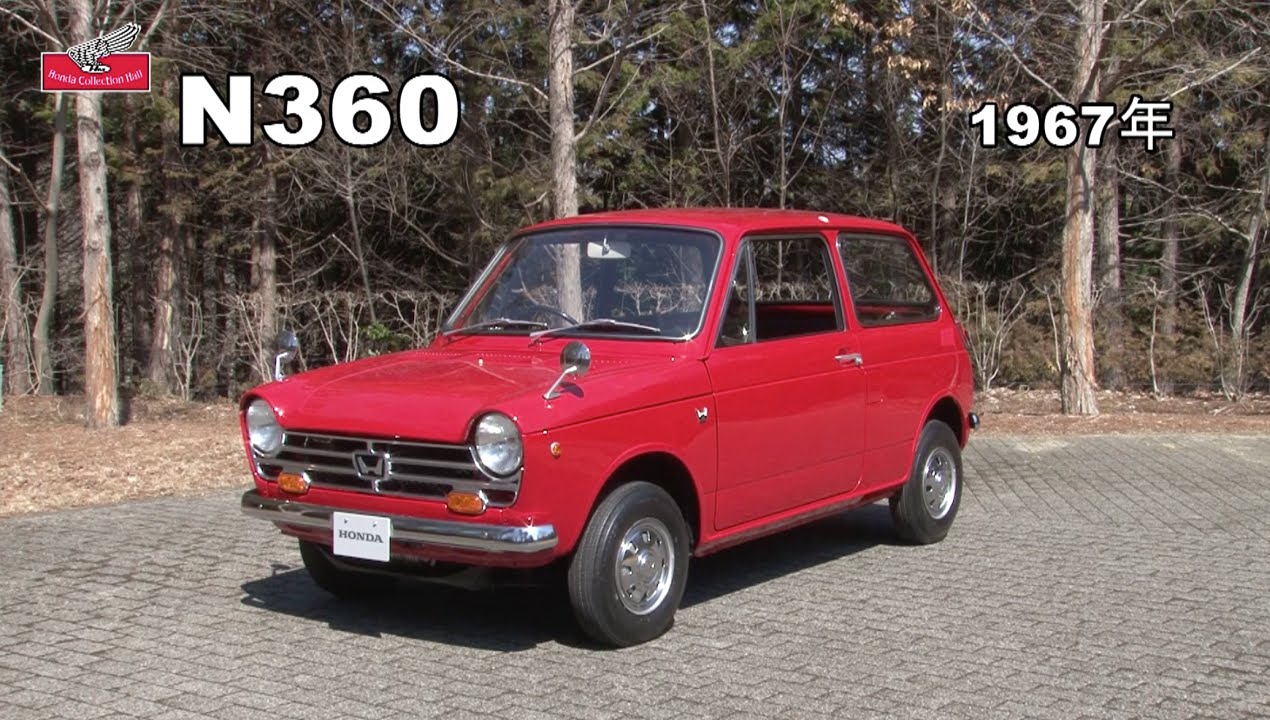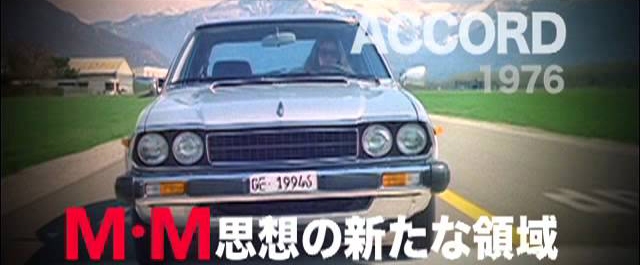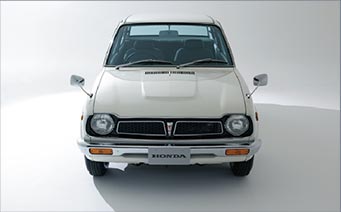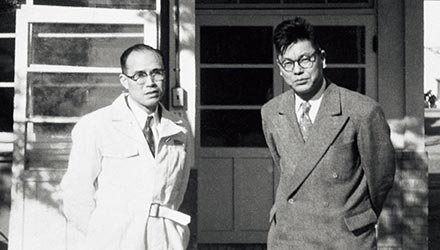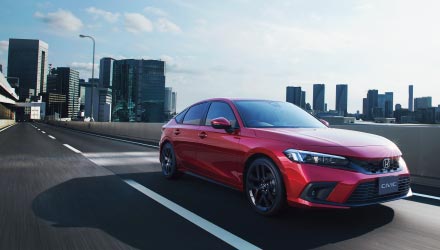Honda’s Answer to the “People’s Car,” Development of the
N360 K-Car
In 1955, MITI proposed the “People’s Car” concept, which called for a four-seater with a top speed of 100 km or more, fuel efficiency of about 30 km/L, and a price tag of 250,000 yen.
In response, Soichiro stated in the March 1959 issue of the Honda Company Newsletter (No. 41), in addition to moving ahead with k-car research:
“The many k-cars that have been produced so far in Japan are by no means appropriate for domestic roads. It is obvious why the cars we have seen not only in Japan but also in other countries are not popular. It is because these cars lack sufficient horsepower.”
He strongly insisted that not only domestic mini cars, but also small cars in Europe, which he toured around this time, were not powerful enough.
In 1959, the Third Research Section’s worked on their first prototype car, the XA170, designed to embody the “People's Car” concept. While Honda developed the SPORTS 360 and T260 based on this prototype, it also pushed ahead with passenger car development.
"The XA170 was definitely the car most closely related to the N360,” recalled Motoo Nakajima, who was in charge of car development at the R&D Center. “With FF [FWD] drive and seating for four people, it can be said to be the basis from which the N360 was derived. The suspension changed because of changes in times, but overall the layout is definitely there.”
The Third Research Section performed test-drives by night, devising plans based on their results during the day. They researched documents and visited junkyards in order to study parts and body structures. At their peak, they worked in two shifts, rapidly amassing the technologies that they would need to create XA170.
Once the Research Center was spun off from Honda and reorganized as Honda R&D Co., Ltd. in July 1960, the Third Research Section developed into the Automobile Engineering Design Room. By 1963, when Honda entered the automobile market by launching the T360 and S500, the Design Room was establishing a system in which advanced research - becoming known as R-research - was promoted
As a result in 1965, at the 12th Tokyo Motor Show, Honda exhibited the N800 prototype, a two-door hardtop compact featuring a monocoque body.
At that time, Japan was in the midst of its rapid economic growth, and the Tokyo Olympics were also an opportunity for rapid expansion of consumer spending. In 1964, Japan became the world’s fourth largest producer of automobiles (1.7 million units) after the U.S., then-West Germany, and the U.K. In 1966, Japan was the world’s third largest producer (2.28 million units), and in 1967, the second largest (3.15 million units). The “My-Car” boom had arrived and manufacturers began to produce 1,000 cc class cars for the masses. The automobile became one of the three most desired items among the public, commonly referred to as the 3C's (color TV, cooler [air-conditioner], and car).
For Honda, it urgently needed to enter the market for mass-market passenger cars.
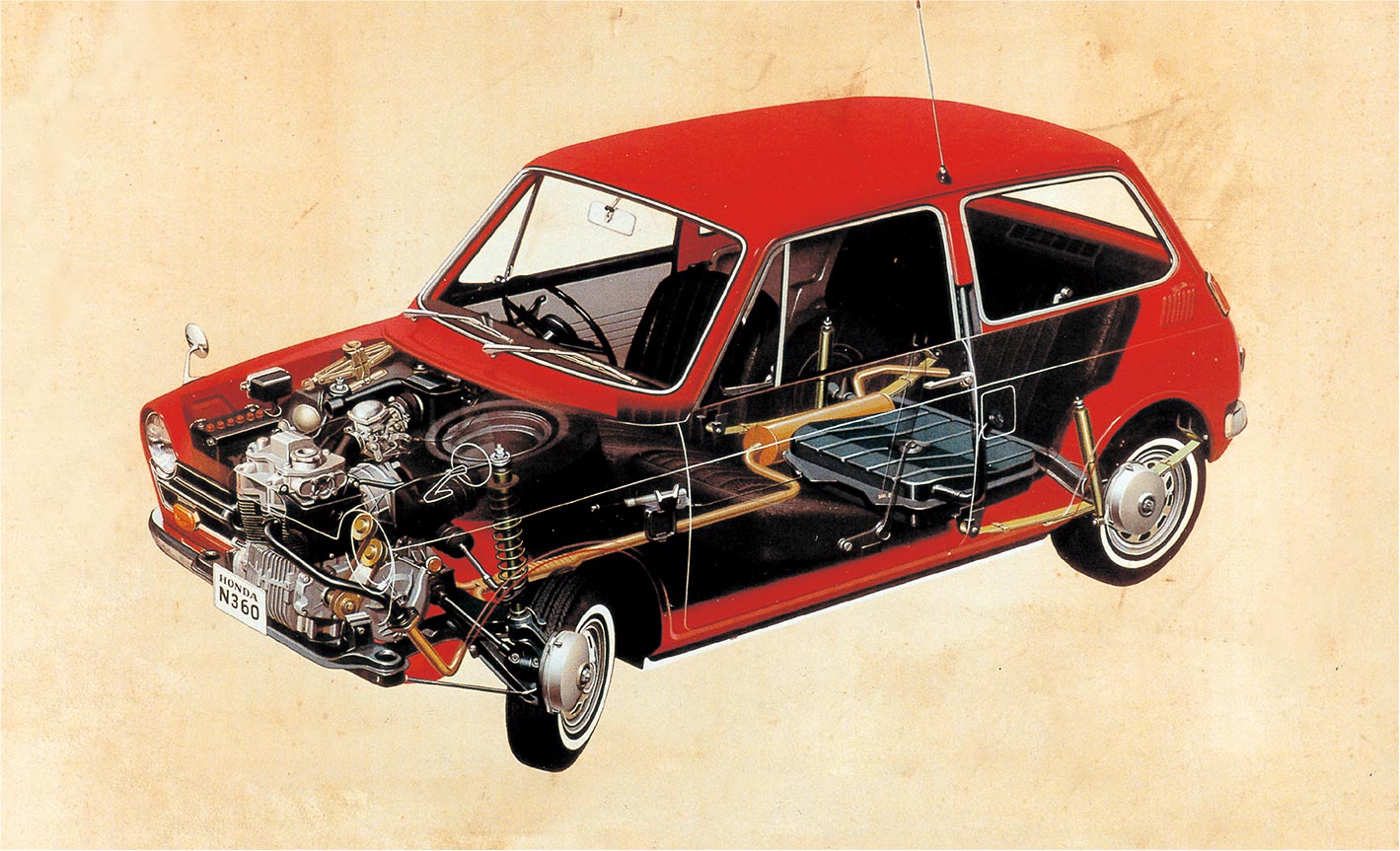
N360 design began with the cabin, with ample space for four people.
“Utility Minimum,” The Human-centric Design Philosophy
Begins with Cabin Design
The Automobile Engineering Design Room considered the direction in which direction Honda’s automobiles should head. Although Honda’s premise was the mass-production of passenger cars, the market for small passenger cars was highly competitive among the leading manufacturers, and for a latecomer to enter the market, it was necessary to have the technology to compete, and a huge capital investment was also needed. In contrast, Honda decided on entering the k-car market, in which its technological capabilities would be sufficient to compete and the investment cost would be less than that for compact cars.
Existing k-cars were slow and uncomfortable, meaning that to ride in them was simply to endure the displeasure of weak performance and cramped quarters. In order to ensure there would be comfortable seating for four, Hideo Sugiura, then the assistant general manager at the R&D Center, suggested, “Why not design a car from the cabin first ?”
“The body was designed by separating the car space into three sections. The engine compartment was designed to be as small as possible, while the cabin was made comparatively large. We equipped the car with trunk space to carry luggage and other items." (Sugiura)
The wheels were pushed out as far as possible toward the four corners of the vehicle, and to avoid the unnecessary consumption of interior space it was decided that front-wheel drive would be used.
This process gave birth to the “Utility Minimum*1” design philosophy of a car that “the customer would be pleased to own,” or that would minimize discomfort, leading to the basis on Honda’s FWD car design philosophy, the M/M (Man Maximum, Machine Minimum) concept*2.
- “Utility Minimum:” To minimize utility space, including the engine compartment, thus enhancing the efficiency of interior space
- “Man Maximum, Machine Minimum:” To maximize the space available for people and minimize the space required for mechanical components
What a Car the ”Customer Would Be Pleased to Own” Is
Once the new year came in 1966, the official project for k-passenger cars was launched, and development moved from the R-research stage to D-development stage.
Nakajima, who was in charge of chassis design, was assigned as the LPL (Large Project Leader).
Nakajima conferred with Soichiro Honda regarding the product’s concept. Through these discussions, Nakajima was told that the car had to be one that “the customer would be pleased to own,” and that, as the manufacturer, Honda would be “proud to sell.” The new car would:
- 1 Be reasonably priced, first and foremost.
- 2 Be easy to drive and easy to get used to.
- 3 Have room for more speed and power, enhancing its performance.
- 4 Have a structure and equipment providing greater safety in all speed
ranges. - 5 Be compact, yet comfortable to ride in, even over great distances.
Soichiro’s sixth requirement, which he sought from the car in the midst of its development, was modern styling. He wanted a car that was both familiar, and memorable.
And so, the N360, a k-car with a unique design that met all the requirements, was completed thanks to the strong desire and commitment of Honda and its development team.
The Need to be Loved by 3 Billion People Worldwide
Honda held a press conference and a test-driving session for its first full-featured, mass-production k-passenger car and light van - the N360 and LN360 - on October 21, 1966, at the Haneda Tokyu Hotel. Nearly 100 press reporters gathered.
The explanation on the N360's many features began with the statement, “This car was designed from the cabin up.” The reporters were told that the car's interior was the most spacious and comfortable in its class, its high-performance and ease of driving surpassed high-class Japanese micro-cars, and it offered active safety mechanisms. The reporters marveled at the car during the test-drive session, saying, “It accelerates off-the line like a sports car.” But, the question of price, which the reporters were keen to know, was left unanswered.
The N360 was exhibited at the 13th Tokyo Motor Show, which ran for two weeks beginning October 26, hosted a record 1.5 million visitors. The N360 was one of the biggest crowd pleasers throughout the crowded show.
The full-page debut ad for the N360 premiered on December 15, 1966, and included the price announcement. It was published in twenty of the country's most popular newspapers. In fact, five different versions of the ad were produced, following careful consideration of the publications, their readerships, and regions of interest.
The N360's price was 313,000 yen, an amount tens of thousands of yen less than the price of competing models.
Soichiro stated regarding the price at a September 1967 ceremony commemorating the company's founding (appearing in the October 1967 issue of Honda Company Newsletter (No. 121)):
“Our policy has always been to have a global outlook, and we always will have that policy. Today, we must build a system as soon as possible so that we can begin exporting the N series. ... We've priced [the N360] at ¥313,000, a price that everyone from the vice president and other executives to each and every one of the sales representatives put their heads together to come up. ... At the time, Japanese k-cars were priced at 370,000 yen and up, but we set our price to 313,000 yen. The N series can still sell well, even at 370,000 yen. ... However, our products are targeted at more than just the population of Japan. The product of skill, intelligence, and creativity should be loved by the Japanese, of course, but even more so by the 3 billion people of this earth. ... So, I would like a price that can be respected internationally, while still bringing profits to our factories and making business feasible. The pricing of the N series is intended to do that. Unless it ensures the feasibility with that price, we can't be called a real business enterprise.”
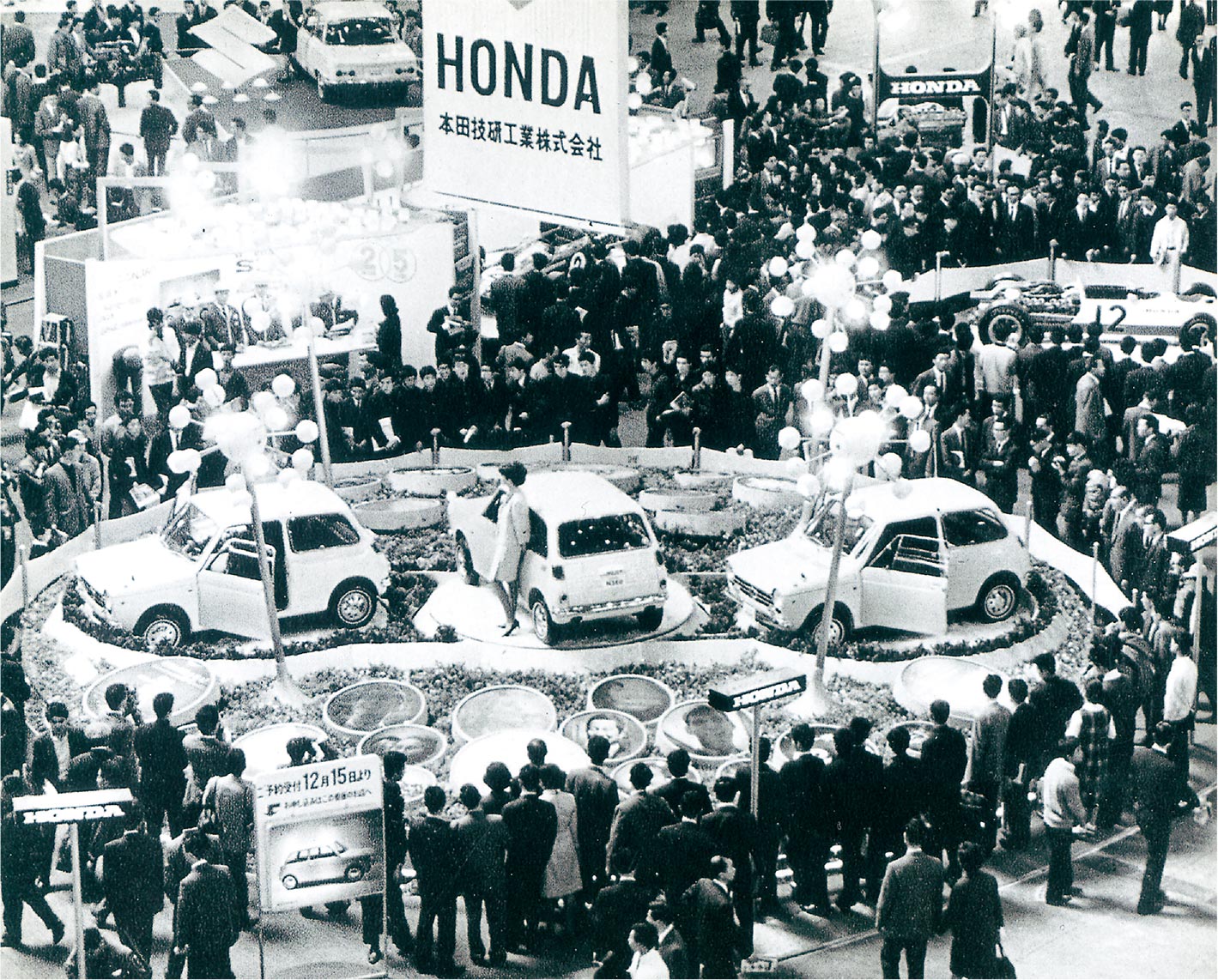
The N360 was the center of attention at the 13th Tokyo Motor Show, held in October 1966.
Remolding the Japanese K-Car Industry,
And Moving on to the Global Market
The N360's sale date was pushed back from February to March 6, with the LN360 commercial mini van going on sale in June. In November, the TN360 - a truck - made its market debut, completing the N series.
The size of the domestic market for k-cars, before the release of the N360, was less than 10,000 cars. However, with the March release of the N360 the market grew to 16,000, then 17,000 in April, and more than 18,000 in May. There was no doubt that the N360 drove the market.
That month the number of N360s registered hit 5,570, becoming the leader in the industry. On June 6, three months after the car went on sale, the accumulated number of total reserved sales reached 22,500 units, reflecting the explosive popularity of this new Honda car. Moreover, both the LN360 and TN360 topped their categories within three months of their debuts. That trend continued with the number of Japanese N-series registrations reaching 500,000 in April 1969, just 26 months after the models hit the market.
Looking to the global market, Honda developed the N600 with a larger, 600 cc engine, and with the N360 prepared its export operations.
Prior to export, the two models were exhibited at the 15th Paris International Motor Show held in October 1967. In the October 1967 issue of the Honda Company Newsletter (No. 121) under the title “Honda N600 and N360 Popular in Europe!” it was reported:
“Last year, Honda exhibited the S800 and S800 coupe, which were very well received, with a large volume of 1,000 units contracted during the show period alone. This year was even bigger. The secret of the popularity of the N600 exhibited this year can be attributed to its lower price of 6,650 francs (approx. 485,000 yen) compared to other manufacturers, and the fact that the excellence of Honda's technology, as shown by its F1 victory, is well recognized.”
It also mentioned that leading French newspapers had reported positively on the performance, comfort, and originality of the car, in prominent articles with photos.
In 1968, exports mainly to Europe began. By September 1970, the cumulative production of the N series reached 1 million units in its first 43 months. In this way, Honda changed the k-car industry landscape in many countries.
In Japan, the N360 the N360 garnered the affectionate nickname "Enu-koro (Little Puppy N). The small car, easy for anyone to drive, with ample power and a roomy cabin, continued to accompany people’s lives in various parts of the world.

The N360 poster. The N360 ignited Japan’s k-car market expansion.
